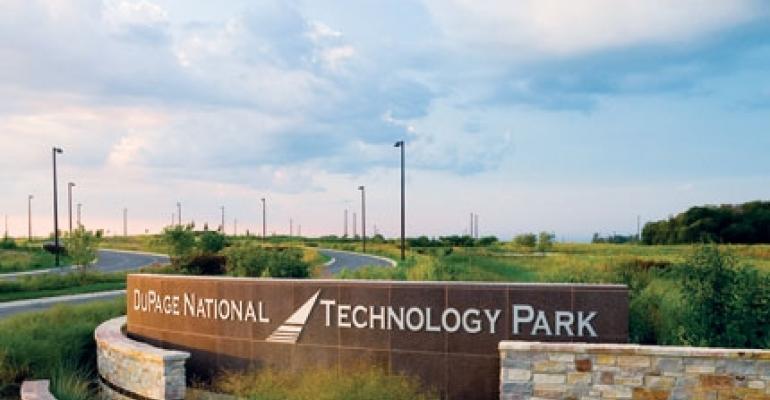A former soybean field in northern Illinois offers a glimpse at what could be the future of high-tech office, research and industrial park development.
Amenities in place or set for the 800-acre DuPage National Technology Park in West Chicago, Ill. include a 10-gigabit Ethernet boasting at least 8,000 times more bandwidth than a T1 line, 10 to 12 fiber-optic network carriers, at least three data centers, two communications hubs and 99.999% data network “uptime.” That level of uptime translates into just 16 minutes of computer network downtime over a one-year span. Officials say the 10-gig network can be expanded to the next standard – 100 gigabits per second. DuPage officials refer to the park as technologically “bulletproof.”
“We’re very, very reluctant to suggest to the world that we’re one of a kind or truly unique,” says Geoffrey Kasselman, president of Op2mize LLC, a Northbrook, Ill.-based commercial real estate advisory firm that is helping market the DuPage park. “We feel that somewhere someone else is doing something like this, maybe better, maybe similar, maybe modeling what they’re doing after us. But we haven’t really found it, and we’ve looked.”

In the past seven years or so, competition for tenants has intensified among the estimated 300 U.S. research parks such as DuPage, says Scott Levitan, senior vice president and development director of Forest City-New East Baltimore Development Partnership LLC and a board member of the Association of University Research Parks. However, unlike DuPage, many of those research parks cater solely to the life sciences sector. Levitan says DuPage is “less focused on a narrow industry band, so the diversity of the intended tenant mix should help mitigate the risk of being in one sector.”
As part of a $1 billion-plus mixed-use project, Forest City-New East Baltimore Development Partnership is building a 31-acre, 1.1 million sq. ft. science and technology park in Maryland.
At DuPage, among the touted benefits is the so-called “plug and play” aspect of the technology infrastructure. Tenants that buy or lease space simply can hook up to the park’s pre-installed infrastructure without having to design, engineer or build infrastructure on their own, Kasselman says.
Situated west of Chicago, the $500 million-plus DuPage development eventually will contain more than 5 million sq. ft. of office, research, industrial, commercial and retail space. CenterPoint Properties Trust is the lead developer. Development of the DuPage project is expected to take eight to 10 years, says Fred Reynolds, senior vice president of development at Oak Brook, Ill.-based CenterPoint, a business park developer. The DuPage park sits on land owned by the DuPage Airport Authority. About 2.6 million sq. ft. is dedicated to companies and research organizations, 2 million sq. ft. is earmarked for industrial tenants, and 600,000 sq. ft. is set aside for retail, restaurants and a conference center.
Reynolds says CenterPoint has chipped in about $10 million for the park’s technology infrastructure; the state of Illinois and the Airport Authority also contributed funding. The DuPage park was designed “to satisfy the data-capacity and information-security demands of 21st century businesses,” Reynolds says.
Those demands are growing. The data-storage and disaster-recovery requirements of the Sarbanes-Oxley Act of 2002 and the Health Insurance Privacy and Accountability Act (HIPAA), whose security provisions took effect in 2003 and 2006, are prompting companies and organizations to undertake the types of technology upgrades not seen since the Y2K scare, Kasselman says. Furthermore, Reynolds says, bandwidth-hungry software, graphics and video are becoming the norm.
The park’s technological capacity is a major draw for would-be tenants. Pella, Iowa-based Pella Corp., a privately held maker of windows and doors, became the park’s first tenant last summer. The company moved its Chicago-area sales and service center, including some IT operations, from Carol Stream, Ill. to a 174,352 sq. ft. building in the DuPage park. DuPage’s technological advantages contributed to Pella’s decision to relocate there, says company spokeswoman Kathy Harkema.
An even bigger tenant is on the horizon. An affiliate of Lake Forest, Ill.-based Cyber Continuity Center LLC plans to take 188,000 sq. ft. at the park. The firm will occupy a 62,000 sq. ft. data center this spring; the company’s second data center, measuring 126,000 sq. ft., is in the works at DuPage. Customers tap Cyber Continuity for primary and backup data-storage and disaster-recovery services. Also, the Transportation Research and Analysis Computing Center, a project of Argonne National Laboratory and the U.S. Department of Transportation, will move into 40,000 sq. ft. this summer. Even biotech tenants are gravitating toward the park: Northern Illinois University plans to establish a $120 million, 100,000 sq. ft. cancer treatment and research center there. Groundbreaking is scheduled for 2008.
CenterPoint is also developing a 66,000 sq. ft. speculative “smart” building that will showcase the park’s attributes. It also will house the park’s second communications hub, a backup to the first one. CenterPoint and the Airport Authority will maintain offices in the LEED-certified building.
Kasselman says obstacles to creating “smart” campuses such as DuPage include an aging U.S. infrastructure, antiquated zoning laws, and investment and lending risks. Jack Tenison, executive director of the DuPage park, says: “We had the advantage of being able to develop the infrastructure from the ground up to service our potential clients.”

